-
Content Count
1613 -
Joined
-
Last visited
-
Days Won
37
Posts posted by Dave Nottage
-
-
11 hours ago, Francisco said:This seems an Embarcadero bug
It's not, e.g:
https://stackoverflow.com/questions/33002829/ios-keeping-old-launch-screen-and-app-icon-after-update
Another possible solution (which I have not tried):
http://arsenkin.com/launch_screen_image_cache.html
Edit: An afterthought - this might not help you since your problem is no splash screen at all. Having said that, I still expect it is not an Embarcadero issue.
-
 1
1
-
-
43 minutes ago, Jose Morango said:[PAClient Error] Error: E2312 H:\Projectos\BimPlatformMobile\Android64\Release\BimMobile5\AndroidManifest.xml:37: error: Error parsing XML: not well-formed (invalid token)
It's telling you exactly what the problem is, i.e. that the xml is invalid. It is likely because you have not correctly added the attribute you mentioned. The application tag should look like this:
On 9/3/2020 at 6:08 PM, Martifan said:<application android:persistent="False"
android:restoreAnyVersion="False"
android:label="For Free"
android:debuggable="False"
android:largeHeap="False"
android:icon="@drawable/ic_launcher"
android:theme="@style/MyTheme.NoTitleBar.CustomBackground"
android:hardwareAccelerated="true"
android:usesCleartextTraffic="true"
android:requestLegacyExternalStorage="true"
android:resizeableActivity="false"> -
-
30 minutes ago, Ian Branch said:If I OK the error and let it continue I end up with Delphi windows scattered on the screen.
That can happen when a desktop (.dst) file becomes "invalid". Try renaming whatever your startup layout is (default is C:\Users\(username)\AppData\Roaming\Embarcadero\BDS\21.0\Startup Layout.dst) and restart Delphi - it should recreate the .dst file.
-
12 hours ago, FPiette said:I always add every file in the project directly
This won't work for cross-platform projects that target more than one platform from a single project.
13 hours ago, limelect said:Now for what is needed. looking for an expert (or just an exe stay on top ) that can alleviate some of the processes.
I started working on something like this a while ago to add to Codex:
https://github.com/DelphiWorlds/Codex
..and just the other day I realised I needed it again. Fortunately the project didn't have a lot of dependent units. It has me thinking I should go back and finish it, though 🙂
-
Background:
I'm working on an implementation of Geofencing on Android, based on this documentation: https://developer.android.com/training/location/geofencing
..and based on their example on Github: https://github.com/android/location-samples/tree/master/Geofencing
To be able to help with this, you will likely need some Java skills, and know about Android intents and receivers. I don't know completely everything about them, hence the request for help
Demo:
I've attached the work in progress demo, which should compile as-is, i.e. it should not be dependent on anything - it uses files from Kastri, but I have copied them into the project.
I've also included the source for the Java parts, as a reference. The corresponding binary is dw-geofence.jar, which is included in the Lib folder of the project.
The demo sets up 3 geofence regions. Tapping the Start button first requests location permissions - in order for geofencing to work, you need to tap on "Allow in settings":
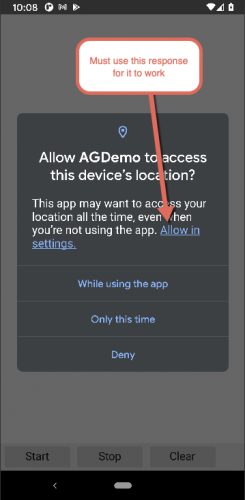
..and select the "Allow all the time" option:
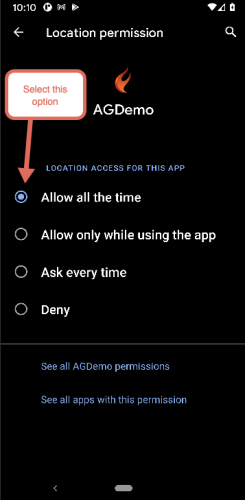
(then tap the back arrow at the top)
If geofence starts successfully, a message will appear in the memo: Action: 1, Result: 0, Message: (Action of 1 = start monitoring, Result of 0 = success)
Simulating changes in location:
So that you don't actually have to physically move anywhere, fortunately on Android it is possible to simulate location changes by using a "mock gps" app, such as this one: https://play.google.com/store/apps/details?id=org.hola.gpslocation
Once installed, you need to go into the Developer Options of the Settings app on the device, and set the mock locations app:
Then use the mock locations app to change your location to one of the geofence regions created by the AddRegions method of TMainView in AG.View.Main in the project.
The problem
I find that when moving into/out of the regions, the GeofenceIntentReceiver is not being "triggered", i.e. onReceive is not being called.
If someone is able to help, it would be greatly appreciated.
-
3 hours ago, OhRio said:i still cannot connect to a desired SSID using java code
How do you mean? Please show your code. Also bear in mind that showing the wifi settings as per the last link provided by Rollo62 does not allow you to select a particular config. The user must do that
-
3 hours ago, Remy Lebeau said:Subnet broadcasting is supported only in IPv4, not in IPv6, you have to use multicasting instead.
..and boy, is that fun 🙄
-
3 hours ago, Juan Martinez said:The problem was that I referenced an old .so file in the Android64 deployment window.
Thanks for that information. It might help other developers who make the same error.
3 hours ago, Juan Martinez said:Dave: THANK YOU VERY MUCH.
You're welcome!
-
 1
1
-
 1
1
-
-
I've tried your app on my Samsung tablet which has Android 9, and the results are the same. It works on my Pixel 3a which has Android 11.
Some questions:
Was the application created in an earlier version of Delphi? i.e. like Delphi 10.3.x, or earlier?
Does the Libraries node under the Android platform in Project Manager look different to this?:
Are there any Java classes that your app uses that you needed to create (or find) an import for? i.e. one that was not supplied with Delphi? If so, which one(s)?
-
1 hour ago, Renate Schaaf said:My problem is, that this offers way too many browsers for the user to choose from, when all that really works is browsing MyDocuments.
By "browsers" I assume you mean "folders"? What does "MyDocuments" actually represent? Does it mean the files contained in the folder returned by TPath.GetDocumentsPath? If so, is there some reason why you cannot iterate the files in that folder, and just present them in a list box?
-
1 hour ago, Juan Martinez said:I have a problem with a comercial android app.
..and its name is? It may help in finding what the problem is from the logs. Better still, what is the package identifier?
Is the app on the Google Play, and if so, is it available in all regions?
-
 1
1
-
-
On 10/20/2020 at 9:16 AM, Massimiliano S said:You would really do me a huge favor
If you have not seen already, Chris Pimlott appears to have beaten me to it:
https://fmxnative.com/ios-extensions-with-firemonkey
-
6 hours ago, Massimiliano S said:At Xamarin I know that all these obstacles have overcome them
You mean it's possible to use an extension of the type you're using in a Xamarin project? Can you find out what their build process does?
I'd like to be able to help you solve this. Can you confirm that the extension you created is exactly the one I asked about earlier? i.e.
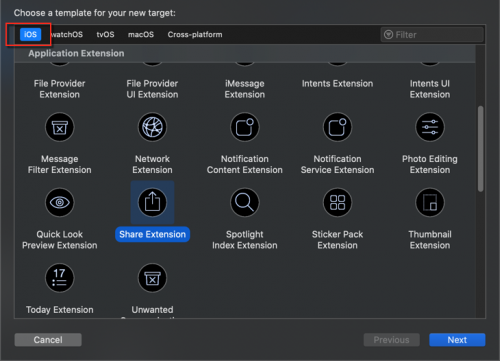
-
Firebase covers a broad range of subjects:
Which one(s) are you referring to?
-
 1
1
-
-
3 minutes ago, Martifan said:how can you find out what style is in the iPhone? (Black or white)
I guess you mean whether it is in Light or Dark mode? If so, take a look at GetUserInterfaceStyle, here:
https://github.com/DelphiWorlds/Kastri/blob/master/Core/DW.UIHelper.iOS.pas
-
 1
1
-
-
6 hours ago, Martifan said:it could be some kind of bug?
Yes, it was a "Dave" bug. Updated demo attached - now allows you to set button type, style and corner radius.
-
18 hours ago, Martifan said:Thank you very much in advance
then I'll wait 🙂 and if you can add round buttons
Has not been successful so far. The initWithAuthorizationButtonType method seems to ignore the 2nd parameter being passed to it, as well as the setCornerRadius method. Very odd
-
1 hour ago, Martifan said:i did so but still the button is black
I'll see if I can debug it, thanks
-
49 minutes ago, Martifan said:Ok, thanks, I just wanted a more round button to do.
How do I change the color of buttons and text on a button? what style is on the phone?
Ah yes, sorry.. the roundness can be changed. I'll take a look at adding that. These are the style values:
ASAuthorizationAppleIDButtonStyleBlack
A black button.
ASAuthorizationAppleIDButtonStyleWhiteOutline
A button with a white outline.
ASAuthorizationAppleIDButtonStyleWhite
Which are displayed in the link I gave:
I'll also take a look at adding support for those.
-
59 minutes ago, Martifan said:I want to change the style of the button or use another button with more effects
The implementation I have done uses the native control, i.e. ASAuthorizationAppleIDButton, which is fairly limited in the styles available. Please refer to:
If you have a sign-in button which does not have a style that is mandated by Apple, your app is likely to be rejected. See:
Examples of rejections:
https://community.auth0.com/t/apple-store-rejected-app-because-of-sign-in-with-apple-styles/43854
https://github.com/firebase/FirebaseUI-iOS/issues/823
For these reasons, I'm not going to be implementing styles other than what they provide.
-
19 minutes ago, Martifan said:Hello, haven't you include other items yet?
Sorry.. been busy with Memorizor. They're still coming. Were you after an installable component for Apple Signin, or something else?
-
On 7/17/2020 at 6:45 AM, Massimiliano S said:[PAClient Error] Error: E0776 error: exportArchive: No 'teamID' specified and no team ID found in the archive
For anyone that might come across this topic: I had this error recently. It was being caused by the less than optimal Version Info grid in Project Options. Somehow the CFBundleExecutable value was changed:
So if you have the same error message, it might pay to check the values in the Version Info section
-
On 9/29/2020 at 6:09 PM, dummzeuch said:Com0Com works for me (on Windows XP and 8.1 (haven't tested Windows 7 or 10)
Com0Com works great, thanks! I'm using it on Windows 10.
Thanks also to everyone else for replying
-
 1
1
-
![Delphi-PRAXiS [en]](https://en.delphipraxis.net/uploads/monthly_2018_12/logo.png.be76d93fcd709295cb24de51900e5888.png)


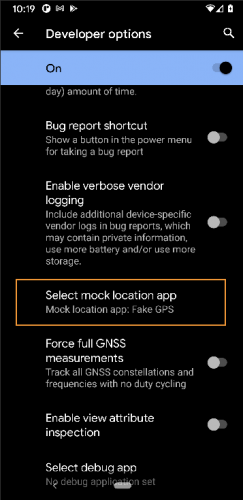
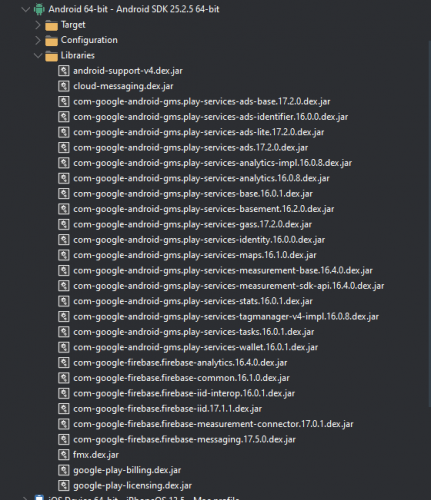

Open android gallery with intent
in Cross-platform
Posted
There is already an import for it in the Androidapi.JNI.Provider unit. In Delphi 10.4.1, starting at line 3658